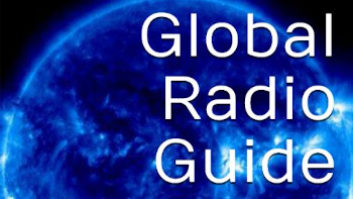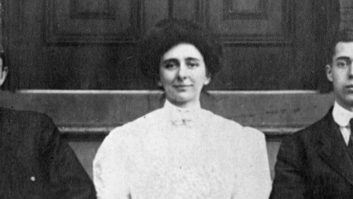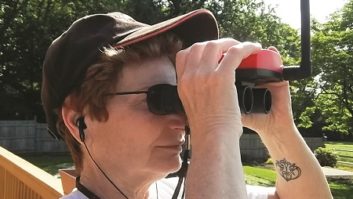FCC-Authorized U.S. Shortwave StationsKAIJ Dallas
Two If By Sea Broadcasting Corp.
KFBS Northern Mariana Islands, SA
Far East Broadcasting Co.
KHBN Medorn, Aimeliik, Palau
High Adventure Ministries
KIMF Pinon, N.M.
International Fellowship of Churches
KJES Vado, N.M.
Our Lady’s Youth Center
KNLS Anchor Point, Alaska
World Christian Broadcasting Corp.
KSDA Agat, Guam
Adventist Broadcasting Service Inc.
KTBN Salt Lake City
Trinity Christian Center of Santa Ana Inc.
KTWR Agana, Guam
Trans World Radio Pacific
KVOH Rancho Simi, Calif.
High Adventure Ministries Inc.
KWHR Naalehu, Hawaii
LeSea Broadcasting Corp.
WBCQ Monticello, Maine
Allan H. Weiner
WEWN Vandiver, Ala.
Eternal Word Television Network Inc.
WGTG McCaysville, Ga.
Blue Ridge Communications Inc.
WHRA Greenbush, Maine
LeSea Broadcasting Corp.
WHRI Noblesville, Ind.
LeSea Broadcasting Corp.
WINB Red Lion, Pa.
World International Broadcasters Inc.
WJCR Millerstown, Ky.
World Wide Gospel Radio Inc.
WMLK Bethel, Pa.
Assemblies of Yahweh
WRMI Miami
Radio Miami International
WRNO New Orleans
Good News World Outreach
WSHB Furman, S.C.
Herald Broadcasting Syndicate Inc.
WTJC Newport, N.C.
Grace Baptist Church
WWBS Macon, Ga.
Charles C. Josey
WWCR Nashville, Tenn.
WNQM Inc.
WWFV McCaysville, Ga.
Blue Ridge Communications Inc.
WYFR Okeechobee, Fla.
Family Stations Inc.
Details: www.fcc.gov/ib/sand/neg/hf_web/stations.htmlU.S. shortwave broadcasters consider themselves rebels – and are proud of it.
Radio’s renegades.
That’s how many broadcasters view privately-owned U.S. shortwave radio stations. They’ve got a point; when it comes to the conventions of commercial AM/FM radio, this country’s 25-odd shortwave stations are anything but conventional.
In fact, the U.S. shortwave broadcast industry is sufficiently different from domestic AM and FM that it has its own lobbying group, the National Association of Shortwave Broadcasters (online at www.shortwave.org ). A look at its membership list reveals stations unknown to most U.S. broadcasters, such as WMLK Assemblies of Yahweh, KAIJ Two If By Sea Broadcasting Corp., and WRMI Radio Miami International.
Missing from the shortwave ownership list are names like Clear Channel and Infinity. Most U.S. shortwave stations are owned by religious groups, while a few others, such as WRMI and WBCQ, are commercially owned.
Restricted access
Why is U.S. shortwave so different?
First, AM and FM are local or regional in coverage, while SW is national or international, thanks to the way radio waves propagate in the 5,000-30,000 kHz area of the spectrum. Like familiar AM signals at night, amplitude-modulated shortwave signals literally bounce off the ionosphere, allowing them to reach thousands of miles beyond the horizon. However, shortwave signals do this all the time, depending on which of the SW bands are used.
The rule of thumb: higher shortwave frequencies bounce best during the day; lower SW frequencies work better at night. Combine this with seasonal ionospheric variations and the sun’s 11-year sunspot cycle, which affects how well SW signals bounce, and one can see that shortwave stations need a number of frequencies assigned to each of them.
Second, in the United States, the SW bands are reserved for international broadcasters.
“When the Voice of America was founded in 1947, it was prohibited from broadcasting domestically, in order to prevent the government from propagandizing to its citizens,” says Larry Magne, editor in chief of “Passport to World Band Radio.”
“The FCC decided that if this rule applied to the VOA, it should also apply to domestic shortwave broadcasters as well.”
Fuzzy business model
However, according to NASB President and WRMI General Manager Jeff White, the FCC’s restriction has an important loophole.
“The current rules do not say SW stations cannot broadcast to the U.S.,” he said. “They say stations cannot broadcast programs that are intended exclusively for an audience in the continental United States.”
As a result, U.S. shortwave broadcasters typically target countries such as Canada and Mexico, with their signals coincidentally blanketing any U.S. territory that happens to be in the way.
For instance, WRMI’s 50 kW North American feed originates from a Florida-based periodic yagi antenna pointed towards Vancouver at 317 degrees.
“With this heading, we manage to legally cover virtually all of the continental United States,” White said.
Then there’s the issue of revenue. Although some U.S. shortwave broadcasters – religious groups such as EWTN Global Catholic Radio and Adventist World Radio, for example – don’t count on making a profit, others, like WWCR, WCBQ The Planet and WRMI, definitely do. But although there are believed to be 600 million shortwave listeners worldwide, including about 5 million in North America, no Arbitron-style ratings service exists to report what they’re listening to.
Without ratings, it is difficult to impossible to sell commercials. As a result, profit-minded U.S. SW stations make their living by selling airtime to whoever wants it. Typically, this tends to be religious or political groups.
The religious programmers run the gamut from mainstream to fringe, while political programmers range from Cuban dissidents to right-wing militia groups. In some cases these programmers work live in the station’s studios. However, it’s more typical for them to send in prerecorded programs on cassette, CD or MiniDisc, or to send in their shows by phone or, increasingly, over the Internet.
The cost? “We charge anywhere from $25 to $65 an hour, depending on the time of day and the number of hours purchased,” said Allan Weiner, WBCQ owner and general manager. Based in Monticello, Maine, the station uses three converted commercial/military transmitters, some home-built antennas and a 1950s-vintage mobile home converted into a studio building.
At WRMI in Miami, Jeff White sells airtime for $1 a minute. Meanwhile, WWCR in Nashville, Tenn., charges anywhere from $15 for 4.5 minutes to $160 for 59.5 minutes, depending on whether you’re buying on a one-day, weekly or Monday-through-Friday basis. With four 100 kW transmitters – a single 50 kW transmitter is considered to be the bare minimum by the FCC – WWCR has more reach and a more sophisticated transmission/production plant than WCBQ or WRMI.
Thus, given the FCC’s restriction on domestic broadcasting, the issues of propagation, audio quality and static associated with amplitude-modulated shortwave and the lack of a measurable audience, the commercial SW market is not one for the faint-hearted.
Add the general public’s lack of awareness of the medium – “People ask me all the time how they can pick up Radio Miami International on their AM/FM receivers,” White said with a shrug – and one can see it’s a tough business.
“The handful of truly commercial stations may generate anywhere from less than $200,000 a year to perhaps a few million,” he added. “These are not Clear Channel-type operations.”
Paying the bills
These broadcasters are willing to put up with poor production quality and content; this comes with the turf of selling airtime blocks. They can tolerate downright weird shows.
“I remember one show where the guy was doing a chant to the angels,” White said. “He just kept chanting the same thing over and over again for 15 minutes.”
In fact, U.S. SW broadcasters are willing to put up with almost anything from their clients, as long as they pay their bills.
“It is still a free country and they have a right to say a lot of things,” said WWCR General Manager George McClintock.
“We pretty much let anyone say what they want,” said Weiner. “Our listeners demand that we be as open and free speech as possible. They crave it. They demand it.”
Besides, “The FCC doesn’t really monitor the content on U.S. shortwave,” White said. “I don’t think they see that as their mission or concern. They are more worried about whether a station’s technical parameters are correct.”
That said, U.S. shortwave broadcasters often suffer grief from their clients’ programming. Even radio’s renegades have their limits.
For instance, WWCR learned that neo-Nazi Ernst Zundel was using his airtime to deny the Holocaust. “We threw the program off,” said McClintock. Zundel had been broadcasting in German, and WWCR’s operators didn’t understand what he was saying.
Even so, many Americans associate U.S. shortwave with far-right broadcasts. This is ironic, given that most of what McClintock calls “militia money” stopped flowing to shortwave broadcasters when the dreaded year 2000 finally arrived. Apparently the New World Order’s “non-collapse,” in McClintock’s words, severely hurt the militias’ ability to solicit donations from listeners.
All in all, U.S. SW broadcasters operate in a strange, Twilight Zone kind of world, but one that they relish. Passport’s Magne believes that U.S. shortwave broadcasters enjoy it so much that they don’t want the FCC to loosen its archaic restrictions on domestic shortwave.
“The truth is that they like it the way it is,” he said. “If the rules were changed, it could open the floodgates to more competition.”
An unfair accusation? Not according to WRMI’s White.
“We discussed changing the rules at the National Association of Shortwave Broadcasters’ convention a few years ago,” he said. “In fact, the FCC asked for our help in doing so. However, after some discussion, a lot of people came to Magne’s conclusion: that we’re all better off just leaving things as they are. After all, under the current regime, the FCC pretty much leaves us alone. If the rules were changed, then they might get serious about enforcing them.”
“If it works for you, leave it alone,” said McClintock. Granted, the FCC shortwave rules are “as loose as a goose,” he said. But “If it ain’t broke, don’t fix it.”










